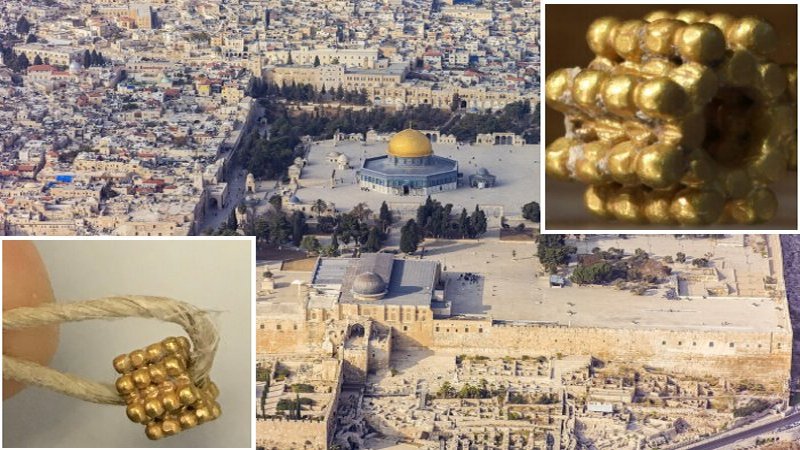Jan Bartek – MessageToEagle.com – A young boy has found a startling 3,000-year-old gold bead on Temple Mount. The preserved minute cylinder created by four layers of tiny gold balls was in so excellent condition that archaeologists didn’t recognize its value at first.
The bead, fashioned from four layers, each made of tiny gold balls that adhere to each other was initially dismissed as a modern “invader” that had accidentally been dropped and ended up in the earth.
It was only later that scientists understood the historical value of the object found by 9-year-old Binyamin Milt from Jerusalem.
Aerial southern view of the Temple Mount from the south. Credit: Andrew Shiva – CC BY-SA 4.0
According to Professor Gabriel Barkay from the Temple Mount Sifting Project the gold bead dates back to the First Temple period, an important period in the history of the Jewish people. The Hebrew Bible informs that the First Temple was built in 957 B.C. during the reign of David’s son, King Solomon. The First Temple allegedly served as an abode for the Ark.
The existence of King Solomon remains a controversial subject. Some historians are convinced he was a real person, but some scholars have also suggested King Solomon was invented as political propaganda to unite people of Judah.
Artistic impression of King Solomon’s temple and its interior. Read more
Whatever the case may be, the archaeological and historical significance of Temple Mount cannot be denied.
Archaeologists have excavated around the Temple Mount for many years and several precious artifacts have been found.
“In the late 1970s, Barkay recovered several almost-identical silver beads that were manufactured using the same “granulation” technique as the newly found gold bead at the site where the silver priestly blessing scrolls — considered the oldest written example from the Hebrew Bible — were uncovered, along with troves of jewelry and other artifacts. According to Barkay, granulation is a decorative technique also known from Phoenician and Etruscan jewelry.
Similar beads were also found at other Holy Land sites in contexts ranging from the 13th century BCE up to the 4th century BCE, with the overwhelming majority dating to the Iron Age (12th century BCE up to the 6th century BCE), according to the Sifting Project,” the Times of Israel reports.
A First Temple-era gold bead discovered in the earth from the Temple Mount Sifting Project. Credit: Temple Mount Sifting Project
How this particular tiny, 6 mm diameter and 4 mm high bead ended up here is unknown. Maybe someone lost it, but scientists explain the production of this tiny object required the ability to melt the metal at high temperatures, and a high level of skill from the artisan.
9-year-old Binyamin Milt at the Jerusalem-based Temple Mount Sifting Project, August 2020. Credit: Temple Mount Sifting Project
“The granules are shaped from tiny metal pieces which are melted on a bed of charcoal or charcoal powder, which adsorbs air, preventing oxidation.
A closer view of the gold bead. Credit: Temple Mount Sifting Project
Once the metal melts, [the] surface tension of the liquid creates ball-shaped drops. An alternative method involves dripping the liquid metal from a height into a bowl and constantly stirring the drops,” project co-director Zachi Dvira told the Times of Israel.
See also: More Archaeology News
Professor Dvira thinks this rare bead was part of a bracelet or necklace that may have left behind other beads.
“If there’s a bead from gold, the person didn’t have just one bead, he or she had a whole piece of jewelry from gold,” he said.
Written by Jan Bartek – MessageToEagle.com – AncientPages.com Staff Writer








